 This picture shows the muzzle of a smooth rifle that was made in Bedford County, Pennsylvania ... a "rifle" without rifling.
This picture shows the muzzle of a smooth rifle that was made in Bedford County, Pennsylvania ... a "rifle" without rifling.
 This picture shows the muzzle of a smooth rifle that was made in Bedford County, Pennsylvania ... a "rifle" without rifling.
This picture shows the muzzle of a smooth rifle that was made in Bedford County, Pennsylvania ... a "rifle" without rifling.
What is a smooth rifle?
The following two questions are frequently asked about smooth rifles:
The information provided below documents early use of the term "smooth rifle" and indicates that at least some smooth rifles were originally manufactured with smooth bores. Contemporaneously, they were also called by the names "smoothbore rifle" and "smooth rifle gun".
L. Dietle
Contemporaneous use of the term "smooth rifle"
1769: I have been informed about, but have not seen, an advertisement in the January 26, 1769 issue of the "Pennsylvania Gazette" that includes the statement, " RUN away from his bail, on the 9th of this inst. January, JOHN DAVIS, this country born, about 21 years of age, about 5 feet 5 inches high, of a sandy complexion, freckled, had a pretty large scar on the instep of one of his feet, occasioned by the cut of an ax, and he is pretty talkative; had on, when he went away, a blue broadcloth coat, with mohair buttons, a red plush waistcoat, leather breeches, and a fine hat; he also had other clothes, of a light ash colour, lined with striped linsey, the coat had no lining in the sleeves; these he had packed up in a pair of check trowsers; he may dispose of one suit; he took with him a smooth rifle gun, and as he has served his time, he may possibly produce his indenture. Whoever secures the said runaway in any goal, shall have FIVE POUNDS reward, paid by the subscriber in Forks township, Northampton county. GEORGE TIDFORD."
1771: Page 147 of Kauffman's 1960 book "The Pennsylvania-Kentucky Rifle" includes a transcript of a list of items from the estate inventory of the early Pennsylvania gunsmith Matthius Ruessor, who died in 1771. The list includes "1 smooth rifle". This shows that the term "smooth rifle" was in use in the 1770s. Pages 329 to 332 of Kauffman's book discuss the Ruessor/Resor family and establish that Mathias emigrated to America in 1736 at the age of 28 and purchased property on King Street in Lancaster, Pennsylvania in 1740.
1773: I have been informed about, but have not seen, an advertisement in the February 17, 1773 issue of the "Pennsylvania Gazette" that includes the statement, "To be SOLD very cheap, for cash only, by CONRAD BATIS, Living in Market street, next door to the corner of Third street, opposite to the goal, in Philadelphia, A QUANTITY of this country and German made RIFLES, both cut and smooth bores, in the best manner; also a quantity of German made GUNS and PISTOLS, likewise gun mountings, barrels and locks, a quantity of violins and violin strings; a reasonable abatement will be made to such as buy a quantity to sell again, of any of the aforesaid articles."
1775: I have been informed about, but have not seen, an advertisement in the May 3, 1775 issue of the "Pennsylvania Gazette" that includes the statement, "TWENTY ONE POUNDS Reward. RUN away, last night, from the subscriber, living near Bush river, Harford county, Maryland, 7 English servant men, viz. John Brown, about 35 years of age, about 5 feet 8 inches high, has black hair, large temples, narrow chin and thick lips, used to the sea, and a great swearer. N.B. Has been in the country before. Abraham Peters, about 28 years of age, about 5 feet 9 inches high, has black hair and beard, of a swarthy complexion, his left hand somewhat perished and lame; says he is a Jew, and talks very good Dutch. John Cooley, about 22 years of age, by trade a Plaisterer, about 5 feet 8 inches high, round face and well set; had on a blue fearnought jacket, and a double breasted under jacket, white yarn stockings, and old shoes. William Childs, about 21 years of age, about 5 feet 6 inches high, a Carver and Gilder by trade, and but meanly dressed, which was a blue fearnought jacket, and old shoes, with hob nails. Thomas Able, about 25 years of age, about 5 feet 5 inches high, has a remarkable red face, very rotten teeth, is a great talker and very much pitted with the smallpox; he has been in South Carolina before. William Blancklett, about 27 years of age, about 5 feet 4 inches high, thin visage, sharp nose, black hair and beard. Thomas Sharp, about 15 years of age, about 5 feet 3 inches high, fair complexion; he had on a green coat, blue cuffs; stole and took with him two pair of trowsers, one striped holland and the other ozenbrigs, one white shirt and one check ditto, new felt hat: As Able and Blancklettbreeches were much worn, it is imagined they wear said trowsers. They had and took away with them a country square barrelled, smooth bore GUN, rifle stocked, one pistol, and other firearms; it is supposed they stole a BOAT from Otter Point. Whoever takes up the said servants, shall have, if taken 10 miles from home, Ten Pounds; if out of the county, Fourteen Pounds; and if out of the province, the above reward, or in proportion for each, including what the law allows, paid by BUCKLER BOND..."
1776: The following September 9, 1776 reference to a "smooth rifle" is from Volume 2 of the 1851 book "American Archives", fifth series.
1807: The following extract from page 373 of the 1881 book "History of Hunterdon and Somerset Counties, New Jersey..." mentions a "smooth rifle":
1807: The following extract from page 141 of the 1948 book "Gullicks and Allied Families 1653-1948" mentions a "smooth rifle gun":
1812: The following transcript of the June 20, 1812 roster of the Berlin Rifle Company of Somerset County, Pennsylvania is from the "Pennsylvania Archives", 6th series. It shows that ten out of 49 men were carrying flintlock smooth rifles.
Circa 1806-1813: The 1963 "McSherrytown Bicentennial Book" mentions a 20-page account book of the gunsmith John Shriver with entries dating from 1806 to 1813. An entry for John Miller pertains to a smooth rifle for 3£, 7 shillings, and 6 pence. This may be a reference to making and selling a new smooth rifle, but there isn't enough information to be sure. McSherrystown is in Adams County, Pennsylvania.
1819: John James Audubon's July 13, 1819 household inventory included a single fowling piece, a duck gun, a double gun, and a smooth rifle.
1824: According to Scott T. Swank's 1983 book "Arts of the Pennsylvania Germans" the 1824 inventory of Abraham Herr at the Lancaster Historical Society lists a "smooth rifle" valued at $6.00.
1825: The following excerpt is from the estate auction of John Bushong, Senior, who was born on June 17, 1760 in Wilmington, Delaware and died in Ross County, Ohio in 1825. It documents the sale of "one smoth rifle gun" for $8.44. The auction was advertised for November 11, 1825. Click here to see the complete page from the estate sale.
1829: Calvin Hetrick's book "The Bedford County Rifle and its Makers" includes a transcript of an account book that William Border purchased on November 1, 1828. An entry from December 21, 1829 documents a charge for the repair of a "smooth boar (sic) rifle gun".
1835-39: Thomas Chandler Haliburton's fictional work "The clockmaker: sayings and doings of Samuel Slick of Slickville", which originally appeared in the "Nova Scotian" during 1835-36, includes the humorous saying, "let's have ... somethin' that will go down the throat like a greased patch down a smooth rifle". The following excerpt is from a subsequent London reprint in book form. The humorous 1839 "Crockett Almanac" includes the variation, "...it went down my throat like a grease patch down a smooth rifle." These sayings inform us that the so-called "smooth rifles" were considered easier to load than actual rifles. This makes sense, because there were no rifling lands for the patch to engage.
1843: The following reference to a "smooth rifle" is from the June 22, 1843 issue of the"Staunton Spectator and General Advertiser" newspaper (Virginia).
1852: The following reference to a "smooth rifle" is from the March 3, 1852 issue of the"Staunton Spectator" newspaper (Virginia).
1857: The following excerpt from a story of an 1857 hunt that was told by William S. Marshall in the 1915 book "Baraboo Bear Tales" uses the term "smoothbore rifle". What is a smoothbore rifle? Marshall's definition is "...an arm fitted with a regular rifle stock, rifle sights and a heavy barrel which was bored out smooth instead of having rifled or twisted bore." A rifle without rifling, if you will.
1862: The following reference to a "smooth rifle" is from the April 16, 1862 issue of "The Weekly North Iowa Times" newspaper.
1875: The following reference to a smoothbore rifle" is from the September 23, 1875 issue of "The Tipton Advertiser" newspaper.
1877: The following extract, which references to a "smooth rifle" is from the July 5, 1877 issue of the "Bozeman Avant Courier" newspaper (Montana).
1878: The following reference to a "smooth rifle" is from the July 17, 1878 issue of the "Clearfield Republican" newspaper (Pennsylvania).
References to making new smooth rifles
The document mentions a December 20, 1774 debt to the estate that was recorded as "finishing 2 smooth Rifles". The document also mentions a June 12, 1776 debt for "cutting a smooth rifle", which I interpret as a reference to adding rifling to an existing flintlock smooth rifle. Gluckman & Satterlee's 1953 book "American Gun Makers" indicates that John Henry's gun shop was in Lancaster, Pennsylvania near the store of his gunsmith brother William Henry I, who had been an apprentice of the early Lancaster gunsmith Mathew (sic) Roeser, who is mentioned above. Regarding William Henry I, page 103 of Dillin's book reports "Lancaster, Pa. Born in Chester County, Pa., 1729; died 1786. Apprenticed to M. Roesser, 1750; later started in business for himself with one Joseph Simons, the firm being known as Simons & Henry. Partnership dissolved 1759."
Page 151 of Kauffman's 1960 book "The Pennsylvania-Kentucky Rifle" provides a list of various activities that are referenced in the business ledger of the Pennsylvania gunsmith Leonard Reedy. Kauffman's list references a ledger entry for "Making a smooth rifle". Kaufman mentions that the ledger contains some 1825 entries but does not give a date for the "smooth rifle" entry. L. Reedy is referenced in Gluckman & Satterlee's 1953 book "American Gun Makers" as making a superposed Pennsylvania rifle with a barrel marked ""KRATZTOWN". Pages 325 to 327 of Kauffman's book establish that Leonard Reedy purchased property in the town of Gratz in 1825, and lived there until his death on April 10, 1835 at the age of 62 years, seven months, and ten days. The borough of Gratz (40.610736, -76.718643) is in Dauphin County, Pennsylvania.
Converting worn rifle guns to "smooth-bore rifles"
Photographs of "smooth rifles" on this website: "rifles" without rifling!
The term "smooth rifle" is currently used to describe dual-purpose smoothbore muzzle loading long guns that incorporate rifle characteristics, including front and rear rifle-type open sights, thick-walled barrels, and rifle-style (versus fowler or musket-style) stock architecture. Considered to be more versatile than a rifled gun, a "smooth rifle" can be used with shot for small game, and is reasonably accurate with a patched round ball at the relatively short distances that large game is typically taken. At longer distances, however, the rifled gun provides significantly better accuracy.
1739: I have been informed about, but have not seen, an advertisement in the September 20, 1739 issue of the "Pennsylvania Gazette" that includes the statement, "RUN away on the 6th Inst. from Thomas Rees, of Heydelburg Township, Lancaster County, a Servant Lad, named Richard Beddes, aged about 17 Years, has light bushy Hair: Had on an old striped linsey Jacket, old linnen Shirt, new Linnen Breeches and an old Hat, no Shoes nor Stockings. Took with him a smooth Rifle Gun. Whoever brings the said Servant to his said Master, or secures him in the County Goal, so that he may be had again, shall have Three Pounds Reward and reasonable Charges, paid by Thomas Rees."

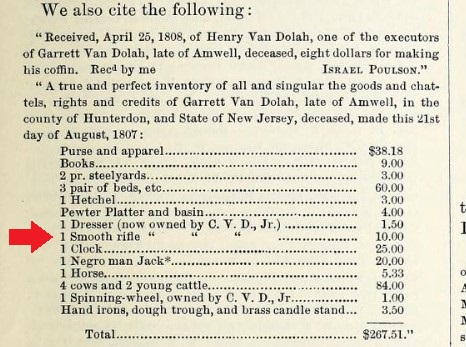

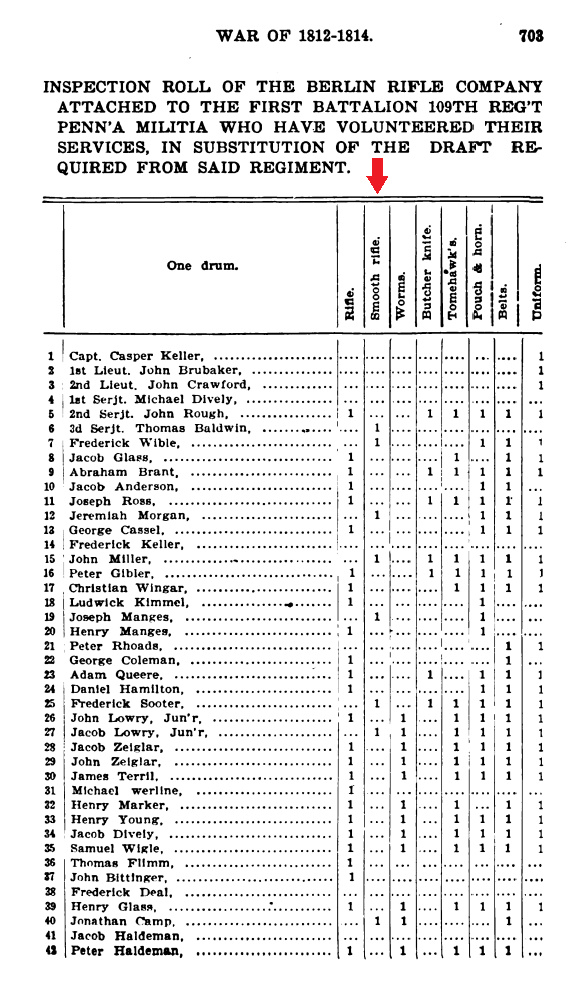
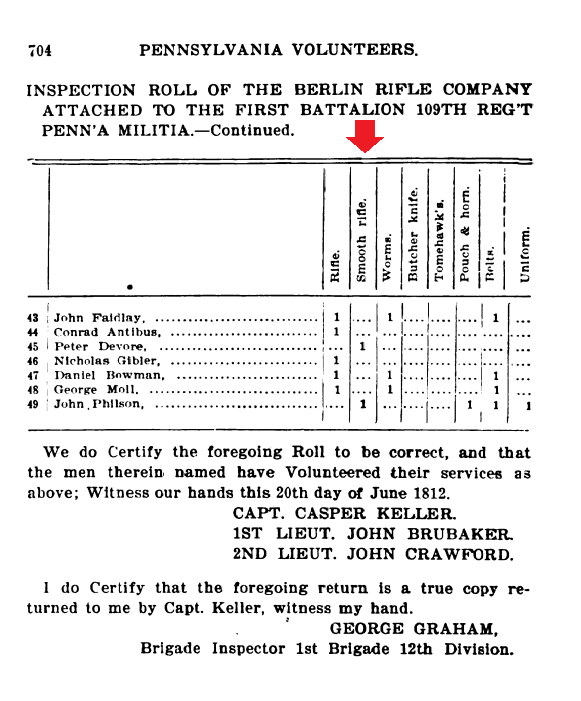


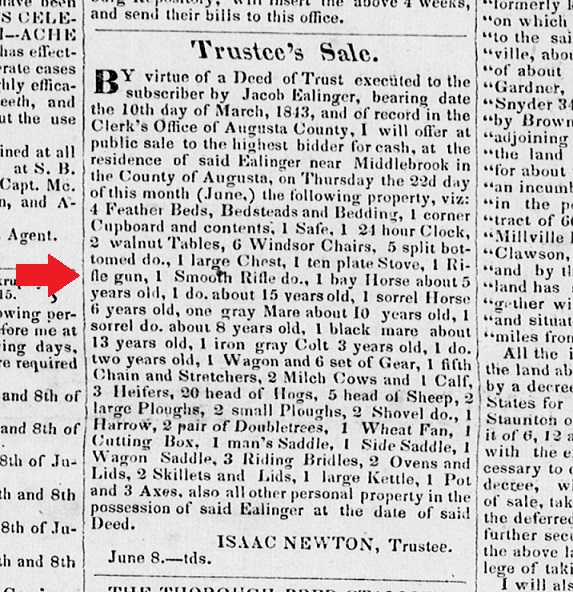



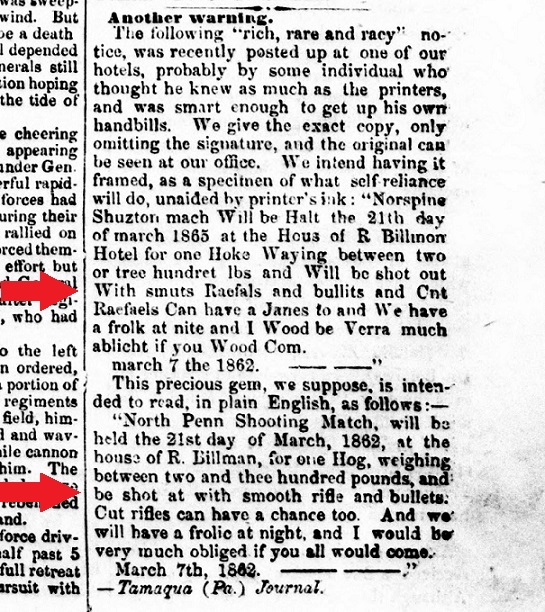
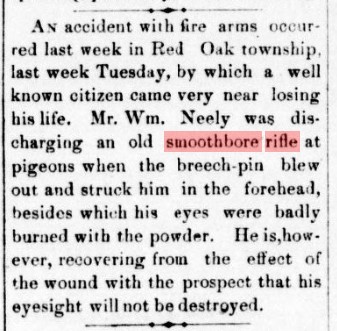

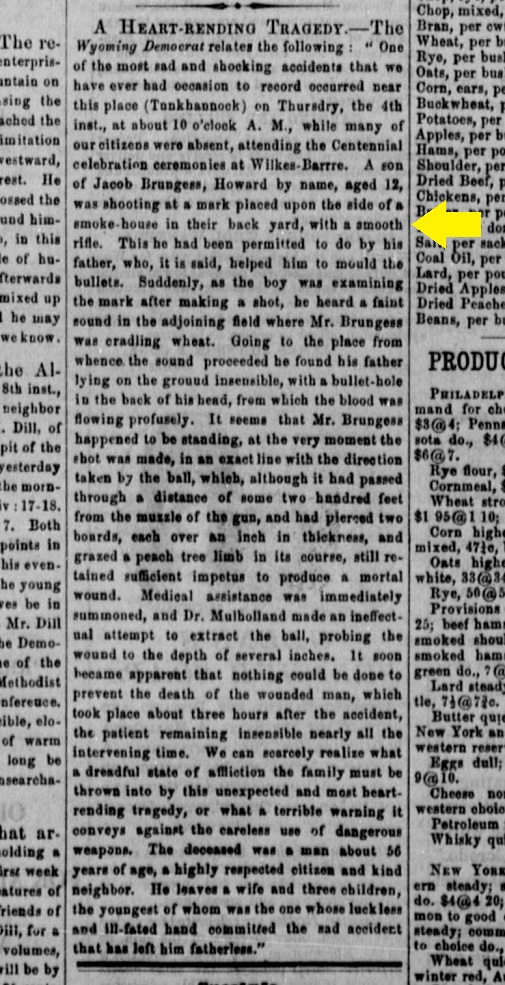
The following transcript of a page from the estate records of the Pennsylvania gunsmith John Henry is from page 46 of Dillin's 1924 book "The Kentucky Rifle". Click here to see a photo of the original document that was taken at the Historical Society of Pennsylvania by Scott Gordon.
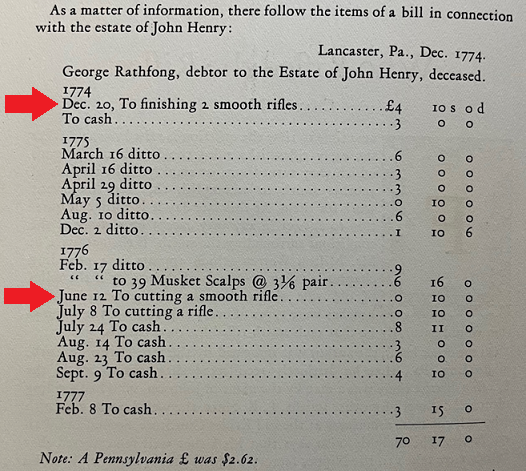
In Chapter 8 of his 1924 book "The Kentucky Rifle", John G. W. Dillin discusses types of barrels on flintlock rifles, and reports that ..."exhaustive research covering several hundred of these so-called smooth-bore rifles disclosed but six specimens which could certainly be classified as original smooth-bore guns. ... All had regular rifle sights. When in doubt as to the original condition of the gun, a lead core was cast in the bore, and an examination of same with a magnifying glass easily determined its original status. Mr. John Laidacker has informed the author that in the late flintlock period an old man in the Lehigh district rigged up a portable machine with which to bore out and smooth the worn-out rifle barrels. He traveled about the country soliciting work of this character. Mr. Laidacker was fortunate in securing the tools he used in this profession." It appears that a bore scope could be used nowadays to help ascertain whether the bore of a "smooth rifle" was originally rifled.
 See the Gunbuilder Index for biographies of early muzzleloader gunbuilders from Somerset and Bedford counties, Pennsylvania, and photographs of the firearms they produced.
See the Gunbuilder Index for biographies of early muzzleloader gunbuilders from Somerset and Bedford counties, Pennsylvania, and photographs of the firearms they produced.